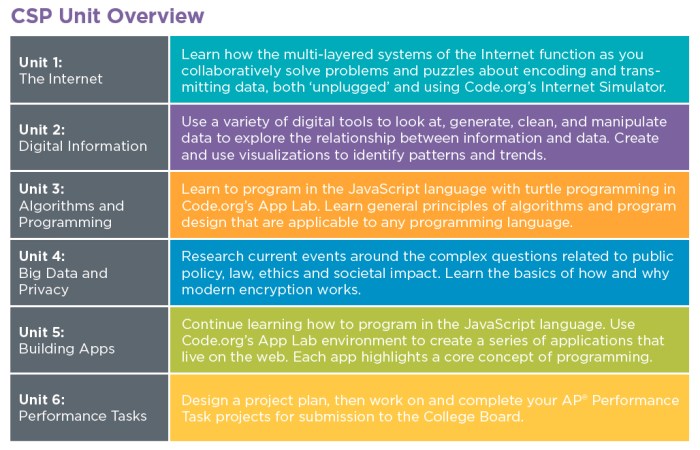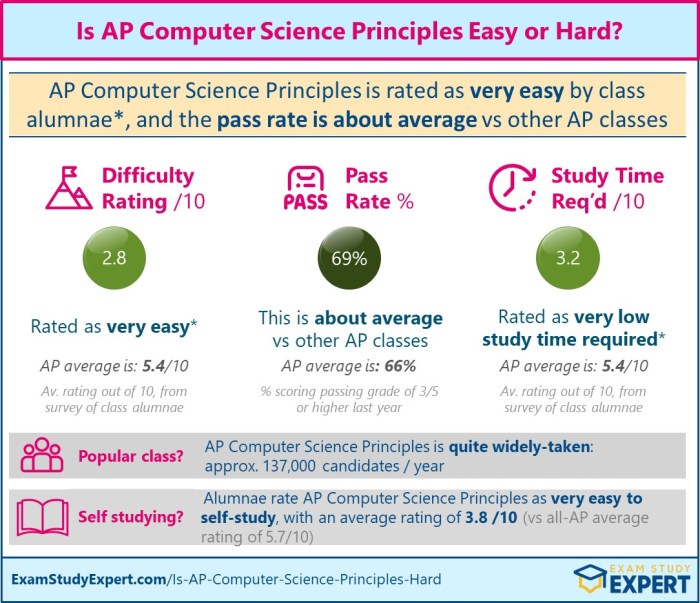Ap csp unit 3 test answers – Prepare to conquer the AP CSP Unit 3 test with confidence! This comprehensive guide provides a treasure trove of expert answers, empowering you to excel in data structures, algorithms, object-oriented programming, file I/O, exceptions, and more. Get ready to unlock your coding potential and achieve test-taking success.
Delve into the intricacies of data structures, master the art of algorithms, and harness the power of object-oriented programming. Explore the practical applications of file I/O and gain a solid understanding of exception handling. With this arsenal of knowledge, you’ll tackle the AP CSP Unit 3 test head-on and emerge victorious.
Overview of AP CSP Unit 3
AP CSP Unit 3 delves into the intricacies of data and its representation, exploring how data is structured, manipulated, and visualized. The unit emphasizes the importance of data analysis and interpretation, equipping students with the skills to extract meaningful insights from data.
Learning Objectives
- Understand the concepts of data structures, algorithms, and data representation.
- Gain proficiency in analyzing and interpreting data using statistical methods.
- Develop skills in visualizing data effectively to communicate insights.
Assessment Criteria
- Multiple-choice questions testing conceptual understanding.
- Free-response questions requiring data analysis, interpretation, and visualization.
- Projects demonstrating proficiency in data manipulation and visualization.
Data Structures: Ap Csp Unit 3 Test Answers

Data structures are a way of organizing data in a computer so that it can be accessed and processed efficiently. There are many different types of data structures, each with its own advantages and disadvantages.
If you’re feeling confident after acing the AP CSP Unit 3 test, why not test your mettle with the AP Psychology Unit 4 exam ? It’s a great way to challenge yourself and prepare for the AP exam. But don’t worry, you can always return to your AP CSP Unit 3 test answers for a quick refresher.
Some of the most common types of data structures include:
- Arrays: An array is a collection of elements of the same type that are stored contiguously in memory. Arrays are accessed using an index, which is a number that indicates the position of the element in the array.
- Lists: A list is a collection of elements of any type that are stored in a linked list. Linked lists are accessed using a pointer, which is a reference to the next element in the list.
- Dictionaries: A dictionary is a collection of key-value pairs. Keys are used to identify values, and values can be of any type. Dictionaries are accessed using the key, which is used to look up the corresponding value.
Data structures are used in a wide variety of programming applications. For example, arrays are used to store data that is accessed sequentially, such as the elements of an image. Lists are used to store data that is accessed randomly, such as the items in a shopping cart.
Dictionaries are used to store data that is accessed by key, such as the names and addresses of customers.
Advantages and Disadvantages of Different Data Structures
The choice of which data structure to use depends on the specific needs of the application. Some of the factors to consider include:
- Access time: The time it takes to access an element in a data structure.
- Storage space: The amount of memory required to store a data structure.
- Ease of implementation: The difficulty of implementing a data structure in a programming language.
Here is a table summarizing the advantages and disadvantages of different data structures:
| Data Structure | Advantages | Disadvantages |
|---|---|---|
| Arrays | – Fast access time
|
– Fixed size
|
| Lists | – Dynamic size
|
– Slow access time
|
| Dictionaries | – Fast access time
|
– Fixed size
|
Algorithms

Algorithms are step-by-step instructions that computers follow to solve problems. They are essential in programming because they provide a clear and organized way to approach complex tasks.
There are many different types of algorithms, each with its own strengths and weaknesses. Some of the most common types include:
- Sorting algorithmsarrange data in a specific order, such as alphabetical or numerical order.
- Searching algorithmsfind specific elements within a dataset.
- Mathematical algorithmsperform complex calculations, such as finding the roots of a polynomial.
Algorithms are used to solve a wide variety of programming problems. For example, sorting algorithms can be used to organize a list of names or to find the highest score in a set of data. Searching algorithms can be used to find a particular file on a computer or to locate a specific record in a database.
Mathematical algorithms can be used to solve equations, generate random numbers, or perform complex simulations.
Object-Oriented Programming
Object-oriented programming (OOP) is a programming paradigm that revolves around the concept of objects. In OOP, a program is organized around objects rather than functions and data. Each object contains its own data, known as attributes or properties, and its own set of methods or functions that operate on that data.
Principles of OOP
OOP is based on three fundamental principles:
- Encapsulation: Encapsulation refers to bundling data and methods that operate on that data within a single unit, called an object. This helps to keep data safe and secure, as it can only be accessed and modified by the methods within the object.
- Inheritance: Inheritance allows objects to inherit properties and methods from other objects. This makes it easier to create new classes of objects that share common functionality.
- Polymorphism: Polymorphism allows objects to behave differently depending on their class. This is achieved through method overriding, where a subclass can provide its own implementation of a method that is defined in a superclass.
Benefits of OOP
OOP offers several benefits, including:
- Modularity: OOP promotes modularity, as objects can be easily combined and reused in different programs.
- Code Reusability: Inheritance allows for code reuse, as new classes can inherit methods and properties from existing classes.
- Encapsulation: Encapsulation helps to protect data and prevent unauthorized access.
- Maintainability: OOP makes it easier to maintain and update code, as changes to one object will not affect other objects.
Challenges of OOP
While OOP offers many benefits, it also has some challenges:
- Complexity: OOP can be more complex than other programming paradigms, especially for beginners.
- Performance: OOP can sometimes be less efficient than other programming paradigms, due to the overhead of creating and managing objects.
- Overuse: OOP can be overused, leading to overly complex and difficult-to-maintain code.
Real-World Applications of OOP
OOP is widely used in a variety of real-world applications, including:
- Graphical User Interfaces (GUIs): OOP is used to create GUIs, where objects represent different elements of the interface, such as buttons, menus, and windows.
- Operating Systems: OOP is used in operating systems to manage resources, such as files, processes, and memory.
- Web Applications: OOP is used to develop web applications, where objects represent different components of the application, such as pages, forms, and databases.
File I/O

File I/O (Input/Output) enables programs to interact with files on a computer system. It plays a crucial role in data storage, retrieval, and processing.
File I/O involves reading data from files and writing data to them. There are various methods for performing file I/O, including:
Reading from Files, Ap csp unit 3 test answers
- Sequential Read:Reads the file contents sequentially, from beginning to end.
- Random Read:Allows reading data from any specific location in the file, enabling faster access to specific information.
Writing to Files
- Sequential Write:Writes data to the file sequentially, appending new data at the end of the file.
- Random Write:Allows writing data to any specific location in the file, enabling updates or insertions at specific positions.
Examples of File I/O in Programming
- Storing user data for later retrieval.
- Reading configuration files for program settings.
- Writing log files to record program activity.
- Processing large datasets stored in files.
- Exchanging data between different programs.
Exceptions

Exceptions are a fundamental part of error handling in programming. They allow developers to handle errors gracefully and prevent programs from crashing unexpectedly. When an error occurs during program execution, an exception is thrown, which can be caught and handled by the program.
There are many different types of exceptions that can occur in programming, including:
- Syntax errors:These are errors in the code that prevent the program from compiling or running.
- Runtime errors:These are errors that occur during program execution, such as when a program tries to access an invalid memory location or divide by zero.
- Logic errors:These are errors in the program’s logic that cause it to produce incorrect results.
It is important to handle exceptions effectively to ensure that programs are robust and user-friendly. There are several ways to handle exceptions, including:
- Try-catch blocks:Try-catch blocks allow developers to catch exceptions and handle them gracefully. The try block contains the code that may throw an exception, and the catch block contains the code that will handle the exception if it occurs.
- Exception classes:Exception classes are classes that represent specific types of exceptions. Developers can create their own exception classes to handle specific types of errors.
- Global exception handlers:Global exception handlers are functions that are called when an exception is thrown and not caught by any try-catch block. Global exception handlers can be used to log errors or perform other cleanup tasks.
Common Queries
Q: What are the key concepts covered in AP CSP Unit 3?
A: Data structures, algorithms, object-oriented programming, file I/O, and exceptions.
Q: How can I effectively prepare for the AP CSP Unit 3 test?
A: Practice coding regularly, review course materials, and utilize resources like this guide for expert answers.
Q: What are the benefits of using object-oriented programming?
A: Encapsulation, inheritance, and polymorphism, which enhance code reusability, maintainability, and extensibility.